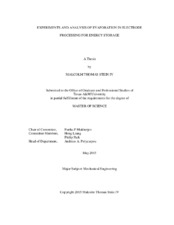| dc.description.abstract | Despite the wide range of ideal applications for LIBs, there is still room for improvement in their performance. While novel electrode materials are typically prohibitively expensive to develop and implement, changes to processing steps represent a cost-effective measure for improving the performance of LIBs that can be implemented almost immediately. Although each step of processing can impact the final microstructure of LIB electrodes, perhaps the most important step is the last: drying. This is when the final microstructure of the electrode is set. During this solvent evaporation stage, a non-uniform distribution of electrode constituents can develop in cases where the solvent evaporation rate exceeds that of the diffusion rate of the mobile electrode constituents. An even distribution of carbon black and binder throughout the electrode is crucial to ensuring the minimization of internal cell resistance, and therefore the maximum performance for a given electrode composition. In this work, we experimentally evaluate the impact of evaporation rate on the distribution of binder and carbon black in the electrode microstructure and the subsequent electrochemical performance.
Chapter I introduces some basic concepts in Lithium-ion batteries and a literature overview of related concepts. Chapter II details the experimental procedures and equipment utilized in this study. Chapter III details the results of experimental evaluation of evaporate rate and a 1-D analysis performed to determine the resulting particle distribution as a function of drying rate. Chapter IV details the post-processing calendering used on electrodes and its result on electrode performance. Lastly, Chapter V details the summary and future outlook for this work.
My analysis has shown that a slower two-stage dry – as opposed to a high-rate single stage dry – allows for an optimal, more even volumetric distribution of binder and conductive additive, thus reducing cell resistance and improving electrochemical performance. | en |


